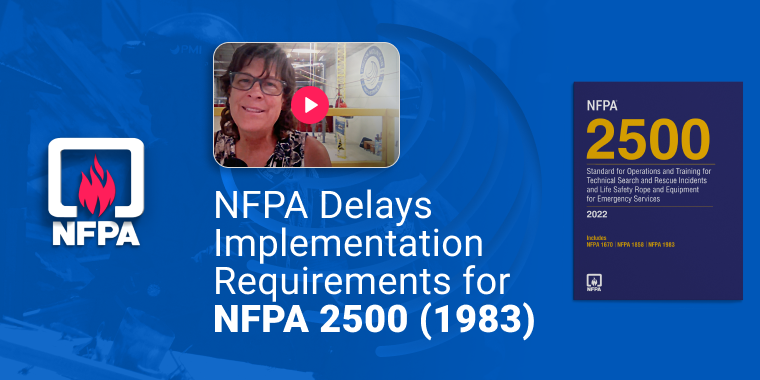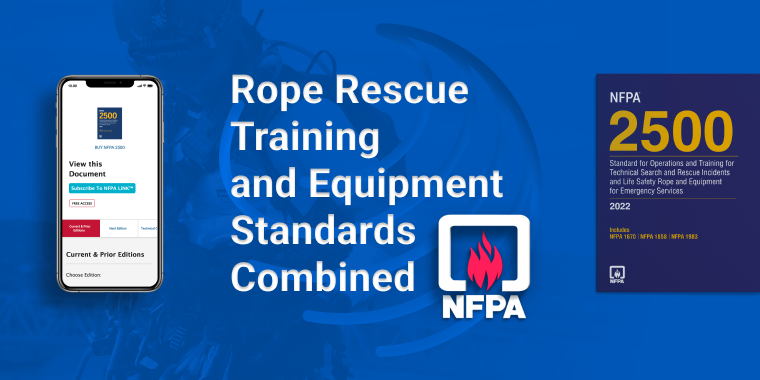PMI News
Does OSHA permit Rope Rescuers to use a Seat-Only Harness? | Part 1
With the many different types of harnesses – and related standards – pertaining to work at height in the USA, this is a question that can cause a great deal of confusion for Rescue Team administrators and purchasing authorities.
”Beginning”
To begin with, OSHA regulation does not address harnesses other than those used for Industrial Fall Protection and Construction Fall Protection (including those used in confined spaces.) The regulatory language in these standards describe harnesses as being part of a fall arrest system that permits up to 6’ fall on a dorsal attachment – something that is generally not acceptable in rigging for vertical rescue operations, due to the increased hazards that would be imposed on rescuers.
“Harnesses for work at height and harnesses for rescue are two very different things”
Sometimes those who are trying to make decisions without the full scope of information can misunderstand this… Harnesses for work at height and harnesses for rescue are two very different things… just as shoes for industrial safety and shoes for mountaineering are two very different things.
Outside of Confined Space operations, OSHA does not actually address rescue, other than to say that a worker who has fallen into fall protection must be rescued promptly. Even in the realm of confined space, which is the only place they really talk about rescue in any detail, OSHA does not address rescue equipment (see interpretation letter which states there are no specifications for rescue equipment.)
OSHA may someday address rulemaking for emergency services responders, but as of now, the few references smattered throughout regulation are inconsistent and out of date (see link). As rescuers we should defer to their own acknowledgment of this and look elsewhere for guidance.
“Best Practice can be a bit subjective”
At present, we are best served to consider Industry Standards (ASTM, NFPA) and Industry Best Practice (what you see happening in real life) as a guide for how to best equip emergency services responders for rope rescue. Industry Best Practice can be a bit subjective and specific to application, environment, or even local custom, so here we will focus on decision-making processes and related standards.
To establish some background for this post, I (the author) have been a member of an active mountain rescue team in the front range of Colorado since 1985. I have also served with two fire departments over the course of my career (plus the Yellow Jackets wildland crew, which doesn’t really apply here…) and have been involved in research, testing, and standards development related to rescue since 1987. I presently serve with NFPA 1983, ASTM F32, and ANSI Z359 standards committees (among others) and am CEO of PMI. We manufacture and distribute life safety rope and equipment, and offer related training through our Vertical Rescue Solutions training arm, for a wide range of work and rescue applications, ranging from Fire-Rescue to Industrial Fall Protection, Mountain Rescue, Caving, and more.
In short, the general approach taken by most responding agencies (and standards developers, for that matter) is that emergency responders should be protected to at least the same level of protection as would be appropriate for the person(s) whom they might be called to rescue. If responding to a confined space emergency, they should be equipped with appropriate confined space PPE and equipment. If responding to a cave emergency, they should be equipped with appropriate caving PPE and equipment. If responding to an industrial fall protection emergency, they should be equipped with appropriate emergency fall protection PPE and equipment. If responding to a mountaineering or climbing emergency, they should be equipped with appropriate mountaineering or climbing PPE and equipment… the list goes on, but you get the idea.
You will notice the phrase above, should be protected to at least the same level of protection… Let’s expound on that a little bit because there is a tendency in our society to lean toward a philosophy that “more is better” – which could erroneously lead to the idea that a full-body harness is better than a seat harness because there is more material there.
Nothing could be further from the truth.
“a very limited range of features that are unique to each type of harness”
Harnesses are designed for different applications with much, much more than just the “seat vs full body” question as consideration. For example:
- some of the more robust rescue harnesses will have a large, supportive waistbelt and a high front-waist attachment, to facilitate greater comfort in suspended operations.
- A caving harness, on the other hand, has a thinner, lighter waistbelt and a VERY low front-waist attachment, so that it adds minimal girth to the caver and works well with a chest harness to facilitate a range of ascending systems.
- A climbing harness will be somewhere between the two, with a front-waist attachment somewhere at or below belly-button level so that the body rotates around the center of gravity in the event of a lead-climbing fall.
- Industrial fall arrest harnesses have as their primary connection point a Dorsal D ring, for compliance with fall protection regulations, and a great deal of heavy metallic D rings for connection…
- and the list goes on.
So far we have addressed only a very limited range of features that are unique to each type of harness, but again I’m sure you get the idea. I hope that you are also beginning to see that what is good for one application is, very specifically, often contraindicated for another.
So, depending on what the rescuer is doing, different types of rescue harnesses might be most appropriate.




0 comment